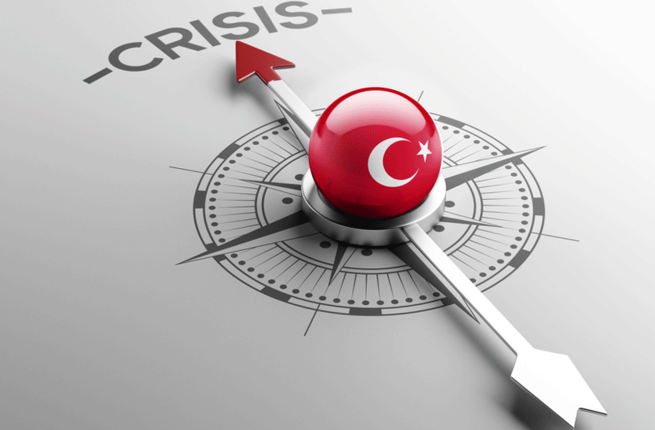Turkey’s gross domestic product shrank 1.5% year-on-year in the second quarter, according to official figures released this week, with a dramatic decrease in investments standing out as a major driver of the contraction. The decline in investments — both in the private and public sector — has been going on for 12 months, bearing heavily on joblessness.
It was the third quarter in a row that the Turkish economy has shrunk. The trend is likely to continue for at least another quarter, as leading indicators point to ongoing contraction in the July-September period. The Turkish Statistical Institute is scheduled to release the third-quarter figure on Dec. 2.
The contraction is even more striking in terms of dollars. The Turkish economy was measured to be worth some $950 billion in 2013. In the ensuing years, the Turkish lira slipped against the dollar, and the economy’s worth was down at $789 billion in 2018. In the first half of 2019, the figure stood at $722 billion on a year-on-year basis. GDP per capita, meanwhile, was $8,800, down from $12,000 in 2014. In other words, Turkey’s GDP and GDP per capita in terms of dollars have sharply declined — especially over the past two years — under the combined impact of a depreciating currency and the economic downtick.
Looking from the optics of production, the only sector that grew in the second quarter was agriculture, expanding 3.4%. In contrast, the industry contracted by about 3% and the construction sector by a staggering 12.5%, while the services sector shrank 0.3%.
The downturn in construction has clearly hit industrial branches that supply materials to builders. Industrial production data show significant decreases in the outputs of manufacturers of cement, bricks, paint, glass, wood, iron and steel. They are followed by manufacturers of durable goods such as cars, white appliances, furniture and electronics, which have been hit by shrinking domestic demand.
Looking at the spending side, one could observe that the second-quarter contraction was limited to 1.5% thanks to the positive impact of public spending and exports. Public spending increased 3.4% from April to June, with net exports also contributing some growth. Still, the decline in the households’ domestic demand and the huge decrease in investments were hard to offset, resulting in an overall contraction of 1.5%.
Investments in the second quarter fell nearly 23% from the same period last year, marking the worst quarter for investments in the past decade. Moreover, it was the fourth quarter in a row that investments have fallen. Cumulatively, this 12-month period saw a nearly 8% decrease in investments year-on-year.
The slump in construction investments was especially sharp. With builders already grappling with unsold housing stocks, a spike in inflation and foreign exchange prices, followed by an increase in interest rates on the lira, further suppressed their investment appetite. The inflation in construction materials prices had reached nearly 40% at one point before easing to 20%, and few could brave investing amid such price volatility, focusing instead on efforts to destock.
The industry faced similar predicaments, forcing domestic and foreign entrepreneurs alike to freeze any investment plans. The steep declines in Turkey’s imports of investment goods and intermediate goods are the direct result of the suppressed appetite for investment.
In previous years, builders would borrow from abroad to launch new projects, but the fragility of the lira and unstable foreign currency prices have now deterred them from seeking external loans. The private sector’s foreign exchange deficit is already more than $185 billion.
The shrinking domestic demand, especially for housing and durable goods, has been the most important factor discouraging investments. Also, foreign creditors have been reluctant to issue investment loans, wary of Turkey’s risk premium. The country’s credit default swaps — a key risk indicator — have been hovering in the region of 400 basis points, roughly double the risk premium of Turkey’s closest peer, South Africa.
The decline in investments is of direct concern to the jobless masses awaiting work opportunities. The wait is likely to be long, both for the skilled and unskilled idle labor force.
As of May, the seasonally adjusted unemployment rate stood at 14% and the number of jobless reached nearly 4.5 million, increasing by 1.1 million over 12 months. Of note, the figure denotes only those actively looking for jobs, excluding the jobless who have given up on the search.
Out of the 1.1 million who joined the army of jobless over a year, 870,000 are people who lost jobs, while the remaining are newcomers to the labor market who have not had the chance to start working. Out of the 870,000 people who lost their jobs, 538,000 were from the construction sector, which was the first to plunge into crisis last year. The industrial sector laid off 123,000 people, while another 307,000 lost jobs in the agricultural sector.
Reviving the investment climate requires a series of coherent economic steps as well as the restitution of confidence among local and foreign investors, especially politically, and the reduction of the country’s risk premium.
Source: Al Monitor



